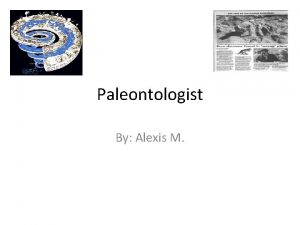On the Cutting Edge Teaching Paleontology in the















- Slides: 15

On the Cutting Edge - Teaching Paleontology in the 21 st Century Cornell University and the Paleontological Research Institute, Ithaca, NY Great Strategies for Teaching Paleontology: Quaternary Faunal Environments Christopher L. Hill Boise State University, Boise, Idaho; chill 2@boisestate. edu

Outline of Presentation �Introduction: What is this activity? �Context �Goals �Activity Description �Adaptations

Introduction: What is this activity? �Use online database FAUNMAP �Compare �Look spatial distribution of mammals at patterns of extinct and extant taxa �Create inferences about past environments

Context �Designed for upper-division undergraduate course in Quaternary Paleontology �Majors in geosciences, geoarchaeology, environmental studies, anthropology �Familiarity with using online resources a basic requirement

Goals �Use present-day (late Holocene) as a basis for understanding past environments �Link �Use to paleoecological patterns online data-sets to observe patterns and develop inferences

Description �Study environments of living North American mammals �Log-on to FAUNMAP: http: //www. museum. state. il. us/research/f aunmap/query/ �Dowload distribution ◦ Taxon ◦ Time Interval �Evaluate patterns �Graded products: ◦ Set of questions ◦ Written Report maps

Class Mammalia Species (* = extinct in North America) Order Didelphimorpha Family Didelphidae Opossum Order Xenartha Family Dasypodidae Armadillo Family Megatheridae Shasta groundsloth* Family Mylondontidae Harlan's ground sloth* Order Insectivora Family Soricidae Arctic shrew Order Carnivora Family Canidae Dire wolf*, gray wolf Family Felidae Cheetah*, saberooth cat*, lion* Family Mustelidae Black-footed ferret Order Proboscidea Columbian mammoth*, Jefferson's mammoth*, woolly mammoth*, mastodon* Order Perrissodactyla Horse (Mexican horse*) Order Artiodactyla Family Camelidae Yesterday's camel* Family Cervidae Stag moose*, caribou Family Bovidae Harlan's muskox*, muskox Family Antilocapridae Pronghorn Order Rodentia Family Muridae Eastern woodrat Order Lagomorpha Family Lepordae Pygmy rabbit, swamp rabbit

Quaternary Faunal Environments Using FAUNMAP at http: //www. museum. state. il. us/research/faunmap/query/ Query the Database o. List of taxa codes o. List of age codes Faunmap Query Form (scientific names) Faunmap Query Form (common names)

Quaternary Faunal Environments Taxon: If we have it for this taxon, do you want the modern distribution? Yes No

Quaternary Faunal Environments Pick the time periods you want to study (note: for some species not all time periods will be represented). [wiho][wisc][lwsc][late][ehlg][holo][emho][mhol][lm ho][lhol][hiho][hist][ALL]

Quaternary Faunal Environments Rangifer tarandus (caribou) ALL (Pleistocene and late Holocene) and only late Holocene

Quaternary Faunal Environments Groundsloth Modern Opossum Extinct Armadillo

Quaternary Faunal Environments Pronghorn Cheetah

Quaternary Faunal Environments Columbia Jeffersonian Woolly

Adaptations �Map downloading could be a team project �If computers are not available, make maps available (good for observation > inference part of the activity) �I tried letting the students pick taxa themselves (small mammals, large mammals, extinct mammals)
 Non cutting instruments dentistry
Non cutting instruments dentistry Chapter 18 basic chairside instruments and tray systems
Chapter 18 basic chairside instruments and tray systems Marking tools in sewing
Marking tools in sewing Lip angle of single point cutting tool
Lip angle of single point cutting tool Hoe excavator dental instrument
Hoe excavator dental instrument Cutting edge technology
Cutting edge technology The cutting edge 2
The cutting edge 2 Cutting edge peter moor
Cutting edge peter moor Cutting edge
Cutting edge Cutting edge packaging
Cutting edge packaging Flyr
Flyr Tools in workshop
Tools in workshop Cutting edge
Cutting edge Cutting edge graphics
Cutting edge graphics Cutting edge technology
Cutting edge technology Cutting edge bolus
Cutting edge bolus





























